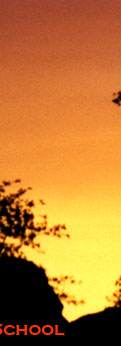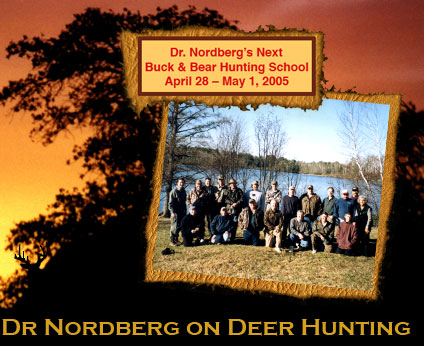|
In a rustic classroom you will learn everything you need to know about whitetails, especially older bucks, and how best to hunt them with gun or bow, all hunting methods scientifically proven to be very superior to traditional hunting methods (no pet theories or ridiculous myths). Doc will then lead you into his famed primary whitetail/wolf/bear study and hunting area where you will see firsthand everything you need to recognize and understand to become regularly successful at hunting adult bucks and trophy-class black bears. Here you will discover the enormous buck hunting value of wolf-inspired "cruise trails," and learn how to properly make and use them. You will learn how to make adult-buck-effective blinds. You will learn how to be close to big bucks every half-day you hunt, using new and improved hunting methods that have enabled the Nordberg family to take more adult bucks since 1990 (in wolf country where experienced deer are especially alert and wary) than during all of their previous hunting seasons dating back to 1945, even surpassing the heyday hunting successes of the 70s and 80s while using elevated stands and buck lure scents. Like hunters from all over American that have attended this school, some two and three times, you will hate to see it end.
The Laurentian Environmental Center (LEC), 12.5 miles north of Virginia, Minnesota and one mile east of Highway 53 on Arrowhead Lake, is an ideal place and late April and/or early May is an ideal time for this school. During this period, shortly after snow-melt, before leaves begin forming and before mosquitoes and ticks become numerous, deer tracks, trails, droppings and signs that reveal favorite browse plants and feeding areas are especially visible. Ground scrapes and antler rubs made during the previous fall appear freshly made. Moreover, at this time whitetails utilize the same areas they frequent after leaves have fallen in autumn. Everything learned about bucks at this time is fully applicable to buck hunting during late fall hunting seasons.
Classroom Instruction
Course subjects - presented from 8 AM to 12-noon, from 1 PM to 5 PM and from 7 PM to 10 PM during one or two evenings - include the following: why older bucks are so difficult to hunt, habits and behavior of all classes of whitetails (5), the whitetail rut, signs of each rut phase (5), where to hunt bucks during each phase, all deer signs (more than 200), deer foods, feeding areas and other range elements, effects of weather and other factors on the timing of whitetail activity cycles, effects of various levels of alarm, evolution of the whitetail's ability to locate, recognize and avoid hunters using elevated stands, adult-buck-effective tree stand hunting, ground level stand hunting, adult-buck-effective stand sites, blinds, stand site approach trails, cruise trails, how to become invisible to deer, how to determine where to hunt next, scouting, mapping, Johnny-on the-spot buck hunting, cover-all-bases buck hunting, the deadly gentle nudge, mile-a-day still-hunting, hunting cornfields, urban areas, swamps, brush lands, hills and mountains, hunting in wolf country and areas where hunter densities are high, calling, rattling, luring bucks with scents, clothing, camo, sizing up bucks, weaponry and much more, including everything you need to know to regularly take black bears weighing 300 pounds or more.
Field instruction
Right from the outset you will see for yourself the enormous value of properly made cruse and stand site approach trails. You will learn to recognize all deer and bear signs. You will learn to walk properly while buck hunting. You will visit feeding areas, buck bedding areas and special areas frequented by older bucks (new). You will visit and study many stand sites where trophy-class bucks were taken. You will learn why these sites were selected, how they were prepared and how and when they were used. You will see where the gentle nudge was often used with great success.
Gear Required to Attend This School
Bring casual clothing for classroom instruction and rugged (hunting) clothing for field instruction. At this time of year, the temperature can vary from 30 to 70 degrees, sunny and calm one day and raining or snowing the next. Whatever the weather, we will spend two days afield. We'll hike through swamps and bogs, which are likely to be wet and muddy. While afield, plan to wear high-top (13") rubber boots, long or light underwear, warm socks (polypropylene), a jacket (warm or light, which ever is appropriate), a rain suit (if necessary), a cap, gloves, a long-sleeved shirt (no bright colors) and denim pants (preferably fairly new, thus mosquito-proof). Much of the terrain will be steep and rugged. Consider using a hiking stick. In a light pack sack, plan to carry insect/tick repellent (30+% DEET), toilet paper, soda, bottled water or a thermos of coffee, a bag lunch (provided) and survival gear such as a compass, knife, matches in a waterproof container, candy, a flashlight, whistle and some rope. Also bring paper and pen (for note-taking), a sleeping bag, pillow, alarm clock and personal gear such as toothbrush, toothpaste, razor, soap, towel, washcloth, Sting-Eze (for insect bites) and whatever medications you might be taking. Bring a swimsuit for the sauna. A camera and fishing gear (good spring pan fishing in Arrowhead Lake) are optional. Keep your valuables in a duffle bag or suitcase that can be padlocked or locked. Do not bring a firearm or bow. Alcoholic beverages are not allowed at LEC and smoking is prohibited inside buildings.
Provided at School
Provided are modern group cabins with bathrooms and showers, bunk beds and three home-style meals daily (all you can eat), plus snacks. Dr. Nordberg will present each student with an autographed set of his currently available books, a set of Whitetail Sign Guides, a camo head net and a diploma. At no time will anyone attempt to sell you anything at this school.
|
|




















